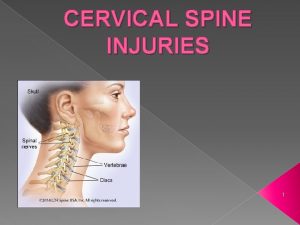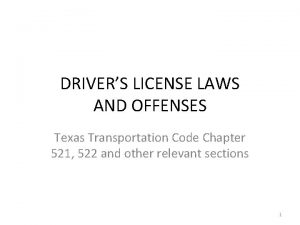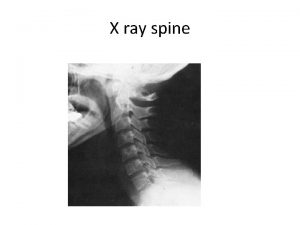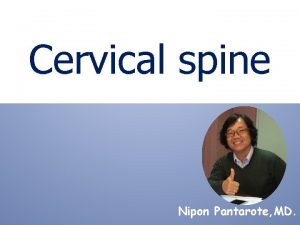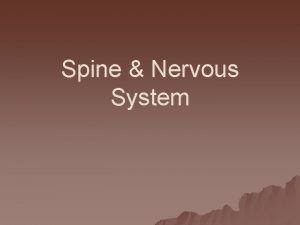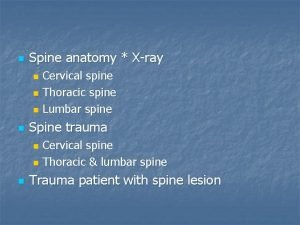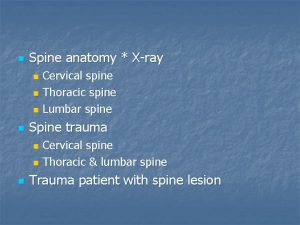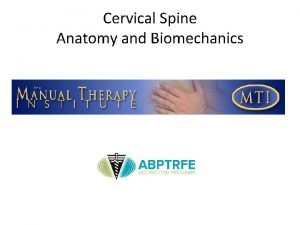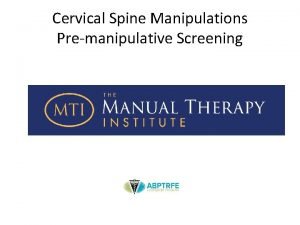Restriction of Cervical Spine Motion ROCSM in the

















- Slides: 17

Restriction of Cervical Spine Motion (ROCSM) in the Trauma Patient Unfolding scenarios Practical skills Reflective self-assessment April 2020 © The Royal College of Surgeons of England 2020. All rights reserved

ROCSM Relevance of content Patients with multiple injuries may have spinal injuries. Restriction of cervical spine motion (ROCSM) is achieved by application of a correctly sized and fitted hard collar in conjunction with blocks and straps. In addition the whole spinal column and cord should be protected with the use of a rigid long board. Efforts should be made to ‘clear’ the spine as expeditiously as possible to prevent damage to soft tissues from the board or collar. It is possible to ‘clinically clear’ the spine in a conscious and fully orientated and alert patient only. Radiographic imaging may need to be used to exclude spinal injury – usually CT scan.

ROCSM Learning Outcomes - by the end of this skill station, you will be able to: • Size and know when to apply a hard collar. • Explain the principles of restriction of cervical spine motion. • Recognise situations where restriction of cervical spine motion may cause harm to the patient.

ROCSM Sizing and application of a hard collar together with blocks and straps for three point fixation. • Ensure that the size for collar in a supine patient is measured by using the distance between a vertical line dropped down from the tip of the chin to where the trapezius meets the neck.

Scenario 1 Cooperative patient with isolated penetrating wound to abdomen. Self-assessment question (suggested responses on next slide): Does this patient need ROCSM?

Scenario 1 No. The patient is cooperative and orientated. The mechanism of injury is unlikely to have resulted in spinal trauma. The spine can be cleared clinically.

Scenario 2 A cooperative but distressed patient with a tension pneumothorax. Self-assessment question (suggested responses on next slide): How might ROCSM fit in with the management priorities for this patient?

Scenario 2 Tension pneumothorax is an immediately life-threatening injury. ROCSM with a hard collar, blocks and tapes would delay its treatment. Options include in line manual restriction of cervical spine motion by an assistant whilst tension pneumothorax is rapidly decompressed.

Scenario 3 A cooperative patient with penetrating injury to neck. Self-assessment question (suggested responses on next slide): How might ROCSM be achieved in this patient?

Scenario 3 ROCSM is desirable in a patient who has had a head and neck injury. However, a collar would result in poor visualisation and access to the wound. An option is to use in line manual restriction of cervical spine motion.

Scenario 4 An uncooperative patient (head injury and intoxicated) who initially refuses restriction of cervical spine movement. Self-assessment question (suggested responses on next slide): Is it appropriate to attempt ROCSM in this patient?

Scenario 4 If the patient is thrashing around, do not attempt ROCSM as this may cause harm. Try to persuade the patient. If the patient were to deteriorate and need ventilation manual inline immobilization should be provided by an assistant during intubation. Collar, blocks and tapes should be applied as soon as possible after intubation to protect the spinal cord.

ROCSM Self-assessment question (suggested responses on next slide): What are the challenges of restriction of cervical spine motion at the extremes of age?

ROCSM Children Many children tolerate ROCSM well if it is applied comfortably. An alternative is to use in line manual restriction of cervical spine motion. A parent can often help with this. In small children the neck will be in neutral position when supine with a pad beneath the torso to compensate for the relatively large occiput.

ROCSM Elderly patients More likely to have fixed deformities of the cervical spine. If fixed deformity is present padding and blocks may be more appropriate to support the spine in the position of comfort. Consider the potential for pressure ulceration in this patient group.

ROCSM You have learned: • How to size and to know when to apply a hard collar. • The principles of restriction of cervical spine movement. • To recognise situations where restriction of cervical spine motion may cause harm to the patient.

Further Learning Hard collars used along with blocks and tapes to achieve ROCSM vary from hospital o hospital. The principle of sizing is always the same but some collars are adjustable and others simply come in a range of fixed sizes. Go and find out what is in use in your Emergency Department.
 Spinal reflexology chart
Spinal reflexology chart Rocsm
Rocsm Clay-shoveler’s fracture
Clay-shoveler’s fracture Definition range of motion
Definition range of motion Icares sti
Icares sti Restriction fragment length polymorphism
Restriction fragment length polymorphism Circular permutations with repetition
Circular permutations with repetition Rflp analysis
Rflp analysis Restriction enzyme mapping
Restriction enzyme mapping Symmetric growth restriction
Symmetric growth restriction Restriction enzymes
Restriction enzymes Restriction mapping
Restriction mapping Iugr
Iugr Restriction enzyme
Restriction enzyme Southern blotting animation
Southern blotting animation Restriction enzyme analysis of dna ap bio lab
Restriction enzyme analysis of dna ap bio lab Texas transportation code
Texas transportation code Student attribute restriction uiuc
Student attribute restriction uiuc


